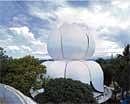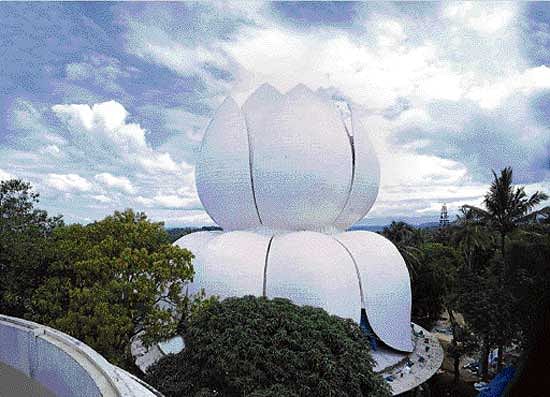

Kerala is all set to add yet another marvel to its rich natural beauty and spiritual heritage - a sublime, full bloomed lotus in white marble, symbolising universal peace, spirituality and fraternity. The structural marvel is located 21 km away from the state capital Thiruvananthapuram, at Santhigiri Ashram, a well known spiritual centre which has hosted VVIPs including former President Abdul Kalam and Sonia Gandhi.
The lotus structure which has been under construction for almost 10 years now is the 'Parnasala' or the final resting place of the ashram's founder Navajyothisree Karunakara Guru who passed away in May 1999. The lotus motif has been used throughout the Parnasala, which resembles the Baha’i Mandir in New Delhi and serves the dual purpose of a spiritual abode and a functional monument. The imposing structure, rising to a height of 91 feet, is fast nearing completion and is scheduled to be opened on September 12, the 84th birth anniversary of the Guru.
The Ashram which began in a humble way in the 1960s is open to all irrespective of caste, class, region, religion or gender. Devotees from as far away as Mexico have sought the guidance of Guru. Among his high-profile disciples were the late President K R Narayanan and cartoonist-writer O V Vijayan. Narayanan had donated his ancestral home at Uzhavoor in Kottayam to the ashram.
According to his followers, the Guru had a universal message - ``God is the same for everyone, everywhere, and is not particular about being worshiped. If you do worship, do it correctly. A human birth is a precious opportunity to gain salvation. Make the most of it. Do not get lost in dogmas and rituals from the past which hold no relevance in the new era - the Kali Yuga. Live as per the 'dharma' (ethics) of the new age.''
Spiritual salvation
Ashram organising secretary Swami Gururethnam Jnana Thapaswi said the Ashram was fulfilling the three-fold mission of activities set by the Guru - 'Annadanam' (free food to all), 'Athurasevanam' (treatment of the ailing) and 'Athmabodhanam' (self-realisation). ``The Parnasala is a functional monument which we, the disciples of Navajyothisree Karunakara Guru, have raised as a token of our love and respect to our Guru", said Rajiv Anchal, film director, sculptor and disciple of the ashram. The Guru had lived with utmost simplicity and austerity in the 'Parnasala', which was then only a one-room tenement with a tiled roof. It was here that Guru attained spiritual salvation in 1973 after protracted struggles.
The lotus shaped superstructure with a radius of 84 feet has 12 lotus petals. Constructed in pristine white marble brought from Rajasthan and special black granite mined in Karnataka, the Parnasala is a visual wonder. It consists of 21 marble overlaid petals - 12 facing upwards and NINE downwards. Almost 100,000 sq ft of marble, transported from Makrana in Rajasthan for the Parnasala, was painstakingly cut into even-sized tiles by workers at the Ashram before being cemented onto the RCC petals. The entire edifice is supported on 21 carved pillars. The 'Baalalayam' or the elevated platform meant for conducting ceremonies is noteworthy for beautiful and intricate wood carving.
Took six months
At the heart of the structure is the Sarakoodam, a 27 foot-high teak wooden enclosure in the shape of a lotus bud with a marble cask inside. Atop the cask, 11 steps lead to a pedestal where a life-size gold sculpture of the Guru will be installed. According to Sreekumaran Nair, the structural consultant for the project, the shaping of the lotus petals took immense effort and skill as the curves had to be executed perfectly and evenly.
The construction of each petal took almost six months and the fixing of the marble tiles claimed another three years. On the first floor of the Parnasala, in 12 rooms, the articles used by the Guru will be preserved.
Outside the Parnasala, colourful floodlights will reflect different colours on the white lotus superstructure during night time. The project is estimated to cost Rs 30 crore.
Landscaping, library, lecture hall and other infrastructure will cost another Rs 20 crore.
What makes the building truly unique is that the design was not given by any architect. In fact, the designing and construction of the monument were carried out completely under the direction of Sishyapoojitha Janani Amritha Jnana Thapaswini, the Guru's foremost disciple and spiritual successor.
As part of the 'Parnasala Dedication' programmes, Sishyapoojitha Jnana Thapaswini, accompanied by nearly 60 'sanyasis', 'sanyasinis' and others had undertaken a four-week pilgrimage of North and West India in November last year.